

WorkWORLD
 |
 |
||||
| Get Latest WorkWORLD |
|||||
|
Friday - May 16, 2025 |
www.workworld.org |
workworld@vcu.edu |
 In this example, you are a recipient of Supplemental Security Income (SSI) working part time, earning $600 per month. You have been offered a substantial pay increase to take on new duties. Unfortunately, you will have work expenses due to the new duties and to your disability.
In this example, you are a recipient of Supplemental Security Income (SSI) working part time, earning $600 per month. You have been offered a substantial pay increase to take on new duties. Unfortunately, you will have work expenses due to the new duties and to your disability.
You use WorkWORLD to see if it makes financial sense for you to take the offer and then you explore the possibility of using either or both of two work incentives, Impairment Related Work Expenses (IRWE) and a Plan for Achieving Self-Support (PASS).
NOTE: This is a complete example, giving you all the information you need to practice using WorkWORLD. Enter the data provided and compare your results to those given in the tutorial.
In this example, you do not intend to enter each situation in succession. You simply want to understand how a number of different possible scenarios might impact your benefits and net income as you consider various ways to improve your job situation. You tell WorkWORLD about your current situation, and then explore several recommendations in conjunction with your specific opportunities.
You may be interested in reading the summary of each situation you will be planning before you start. Click on this link to read the summary at the end of this topic, and then click the "Back" button on the Help window to return back here and begin the tutorial.
NOTE: To keep the tutorial instructions in the Help window on screen along with the program Window, you will need to change the normal behavior of the Help window to "Keep Help on Top". Find this by clicking on "Options" on the Help window menu bar, or typing <Alt> + <O>. Use your mouse pointer or down arrow key to highlight first "Keep Help on Top", and then "On Top". Finally, either click on that choice or hit your enter key. That will allow the help topic to remain visible while you follow its instructions. To change this behavior, select "Not On Top". The Default is Not on Top.
NOTE for non-mouse users: If you use the keyboard keys rather than a mouse to operate your computer, you can switch back and forth between the main program window and the Help window using the <Alt> and <Tab> keys:
![]() +
+ ![]()
Hold down the <Alt> key and then press and release the <Tab> key. A small window will pop up with icons along the top representing the program screens from which you may chose. A blue box will appear around the icon of the selected program, and its screen title (the text that appears in the blue title bar at the top of each screen) will display along the bottom of the pop-up window.
While you hold the <Alt> key down, each time you press and release the <Tab> key, the selection will cycle through the available windows. When you have selected the window you want, release the <Alt> key and that window will display on your screen.
A list of keyboard navigation shortcuts may be found in the Navigating WorkWORLD and Entering Data topic.
To begin the tutorial, you must create a New File.
You may use one of several methods to begin this process:
If you have just opened WorkWORLD and are at the opening screen:
![]() You can select "Create a New File" from the opening screen by left-clicking on it with your mouse;
You can select "Create a New File" from the opening screen by left-clicking on it with your mouse;
![]() Or simply by pressing the <Enter> key on your keyboard, because the focus box is around "Create a New File".
Or simply by pressing the <Enter> key on your keyboard, because the focus box is around "Create a New File".
If you have already opened WorkWORLD and are at the program’s main screen:
![]() You can left-click on the "New File" icon on the toolbar in the program’s main screen, the Input screen.
You can left-click on the "New File" icon on the toolbar in the program’s main screen, the Input screen.
Or left-click on File and then New from the main menu in the program.
![]() +
+ ![]() ,
, ![]() Or hold down the <Alt> key on your keyboard and press <F> (capital or lower case), and then release <Alt> and press <N>. [From this point on in the tutorial, we will use the following notation for this kind of action: <Alt> + <F>, <N>]
Or hold down the <Alt> key on your keyboard and press <F> (capital or lower case), and then release <Alt> and press <N>. [From this point on in the tutorial, we will use the following notation for this kind of action: <Alt> + <F>, <N>]
If you started from WorkWORLD’s opening screen, you will then see the first question, asking you if you want to name the situation.

You will also see "QUESTIONS PENDING" in the status bar near the bottom of your screen on the WorkWorld status bar:
![]()
And the Text Results window will be displayed on the bottom half of your screen. On the left side of that window a message explains that the situation is incomplete and that it requires you to enter more information before WorkWORLD can calculate valid results:
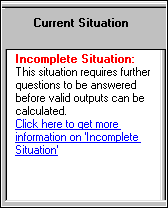
If you started this tutorial from WorkWORLD’s main program screen and had a previously opened file with unsaved changes on screen, then a pop-up message will ask you if you want to save the open file:
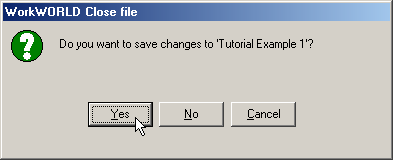
If you have entered information in the previously opened file that you want to save, select Yes by left-clicking on it or by using <Alt> + <Y>; otherwise select No by left-clicking on it or by using <Alt> + <N>.
You will then see the first question, the "QUESTIONS PENDING" note in the status bar near the bottom of your screen, and the "Incomplete Situation" message (shown and described above) on the bottom left side of your screen.
You are now ready to begin entering information about your current situation.
For purposes of the tutorial, assume that you are a recipient of Supplemental Security Income (SSI) who has a part-time job earning $600 per month.
· The first question asks you to enter a brief name for the situation you are about to describe with your answers. The default is "Current Situation." To accept the default:
Press <Enter>; or
Left-click on the Okay button.
(If you want to enter a more descriptive name, one that will help you to remember something about the situation, type something like "Earning $600" and then press <Enter>.)
· You are then asked to select the month and year of the situation. The default is the current date. Select "Sep 2000":
Use your <Up arrow> or <Down arrow> keys to choose "Sep 2000" and then press <Enter> to accept this as the date whose rates will apply to this situation; or
Use your mouse to scroll to Sep 2000 and left-click on that date and then left-click on Okay
(If you were to choose a different date, one or more of the rates—such as the SSI Federal Benefit Rate (FBR)—could be different from what they were when this tutorial was created, and your results would differ from those shown in the tutorial.)
NOTE: From this point on, we will provide directions primarily for keyboard entry and navigation, although we will also give mouse directions for actions not yet discussed. You are free, of course, to use the mouse if you wish.
· The next question asks you to choose the State that you are in.
Use your <Up arrow> or <Down arrow> keys to select Arkansas. (For simplicity we have chosen a state without a SSI State Supplement). Press <Enter> to accept that you live there.
· You are asked if you receive Supplemental Security Income (SSI - Title XVI) benefits:
Press <Enter> to accept YES, the default, as the answer.
· The program asks if SSA notified you that a final determination that you are eligible for SSI has been made:
Press <Enter> to accept YES, the default, as the answer.
· You are then asked if you receive Social Security Disability Insurance (SSDI - Title II) benefits.
Press the keyboard <Down arrow> to select NO and then press <Enter> to accept NO, you do not, as your answer.
· You are then asked if you receive Medicaid benefits.
Press <Enter> to accept the default, YES, you do.
· You are then asked if you want general information about other disability and welfare benefits.
Press <Enter> to accept the default, NO, you do not.
· You are then asked if you live alone.
You are living with a roommate and paying your share of expenses, and you wonder if that means you are "living alone" so you left-click on the "More Info" button or use <Alt> + <M> to bring up the following screen:

It explains that if you are paying your share of expenses, then SSA considers that you are living alone.
Return to the question by:
Clicking the "X" in the top right-hand corner of the help screen (the Windows "close" button) or by pressing "Esc" to close help:
![]() or
or ![]()
Or, you can minimize help and return to the questions by Clicking on the Windows "minimize" button in the top right-hand corner of the help screen:
![]()
If you have minimized the help screen, you can make it pop back up later by clicking on its icon at the bottom of the screen in the Windows task bar:
![]()
To continue answering questions: Either left-click on the answer with mouse, or your press the <Tab> key two or three times to highlight the current answer. (Highlighting the answer allows you either to accept the current entry by pressing <Enter> or to choose a different answer).
You accept YES, you do live alone by pressing <Enter> to accept the highlighted default YES.
· You are asked if you are considered legally blind by SSA.
Press <Enter> to accept NO, you are not.
· You are asked if you have a disability as determined by SSA.
Press <Enter> to accept YES, you do have a disability as determined by SSA.
· You are asked how old you are.
Press <Enter> to accept the default, that your age is between 22-54 years old.
· You are asked the value of your resources.
Your only countable resources are modest checking and savings accounts. You just received your bank statement in the mail, so you type 789.95 and press <Enter> to accept.
· You will be asked if a previous over- or under-payment of SSI is causing your current SSI check to raised or lowered.
Press <Enter> to accept NO. (SSA will inform you before raising or lowering your check because of a previous over- or under-payment—and you have the right to appeal.)
· You are asked your actual monthly SSI Check Amount.
NOTE: WorkWORLD asks for your actual check amount in order to insure that it calculates correctly your actual check given the situation you describe with your answers. If WorkWORLD does not calculate the amount correctly, then it can not hope to calculate "What-If" situations correctly. In that case WorkWORLD will give you a result that tells you all of the things you should check to find out why the calculated results differ from actual. It is very important that you find out the reason for a check amount descrepancy. You may not be receiving the full amount you are entitled to, or you may be receiving an Overpayment that you will have to pay back later!
Type 254.50 as your actual check amount. Press <Enter> to accept.
NOTE also, however: If you were entering this as a hypothetical case and did not know the actual SSI check amount, you can accept the $0.00 default and wait until you are told in a Text Alert what the number should be. Then come back to this question and enter that number. This question is only asked in the "Current Situation" column, not in the "What-If?" columns.
· You will be asked if you have any "Unearned Income," that is, any income other than SSI or earnings. (If you wish, click on unearned income to get "More Info" about SSA’s definition of "Unearned Income".)
Press <Enter> to accept NO, you have no other income but earnings and SSI.
· You will be asked if you have any "Earnings," that is, any income from wages, salary, or self-employment.
Press the <Up-arrow> to select YES as your answer, and then press <Enter> to accept YES.
· You will be asked how much you receive in earnings.
Type 600 as your wages per month. Press <Enter> to accept.
· You will be asked if you have any work expenses due to your disability.
Press <Enter> to accept NO.
· You will be asked if you have any other work expenses.
Press <Enter> to accept NO.
· You will be asked if you are spending or saving for training, equipment or other employability investments.
Press <Enter> to accept NO.
· You will be asked if you want WorkWORLD to calculate results for Section 8 Housing.
Press <Enter> to accept NO.
· You will be asked if you want WorkWORLD to calculate results for Food Stamps benefits.
Press <Enter> to accept NO.
As soon as you answer that last question, WorkWORLD calculates the results and you can look at them.
NOTE: If you are keeping the tutorial on top and the "Help Information System" screen is covering the Text Results, you can move, re-size or minimize the screen. Minimize it by clicking on the minimize button in the upper-right corner of the screen:![]()
Move the screen by moving your mouse pointer to the top of the screen until it becomes a single arrow, and then drag the screen by holding down the left-clicker and moving your mouse.
![]() If Text Results are not visible, click the Text Results tab in the lower left corner of the screen, or use the keyboard combination <Alt> + <N>.
If Text Results are not visible, click the Text Results tab in the lower left corner of the screen, or use the keyboard combination <Alt> + <N>.
You notice that the Text Results contains a recommendation having to do with PASS Possibilities:
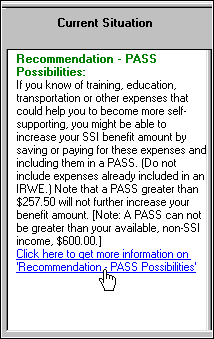
The recommendation says that you might be able to increase your SSI benefit amount if you know of work expenses and/or employability investments you could include in a PASS. It also says that a PASS greater than $257.50 will not further increase your benefit amount.
You look further into this possibility by clicking on the "More Information" hyperlink below the recommendation, and the following screen pops up:
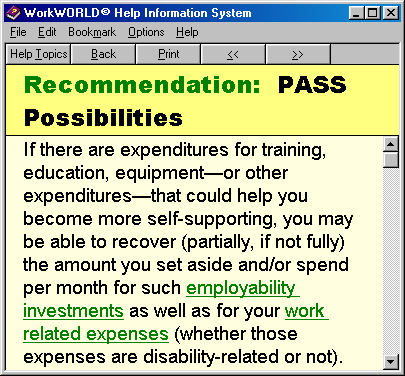
This screen tells you that if you know of expenditures that could help you become more self-supporting in the future, then you could recover them by including the amount in a Plan for Achieving Self-Support (PASS) in order to increase your SSI benefit amount. The screen also allows you to click on a number of the terms for further explanations of their meaning.
Since you are not aware of any expenditures that could help you become more self-supporting, you minimize the "More Information" screen and go on to look at your numerical results.
![]() Switch to the Numerical Results either by clicking on the tab (located on the bottom left of the Results screen) or by using <Alt> + <N>.
Switch to the Numerical Results either by clicking on the tab (located on the bottom left of the Results screen) or by using <Alt> + <N>.
Here is what you see:
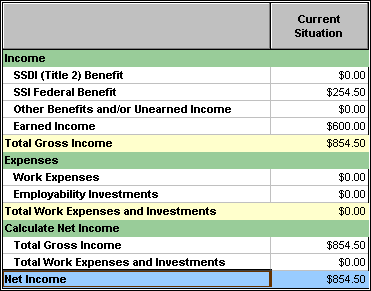
Your computer may not have its display set to a resolution high enough to see all of the numerical results table. You can have WorkWORLD use more of the screen area for display of outputs by clicking the Output button on the toolbar near the top left of the screen. From the keyboard, use <Alt> + <V>, then <O> to use the main menu commands View, Outputs to accomplish the same thing. Return the screen to the previous view by clicking the I/O button on the toolbar, or use the main menu commands View, Inputs & Outputs from the keyboard by using <Alt> + V, then <N>.
WorkWORLD calculates your SSI benefit to be $254.50, the same as the actual check amount that you entered. Your earned income is $600, and with no work expenses or employability investments, your Net Income is $854.50.
The real reason that you are using WorkWORLD is that you have been offered a substantial pay increase if you will take on some new duties. Unfortunately, the new duties will require you to work out of a different office. To commute there you will need, because of your disability, to use the Para-transit system at $100 per month. You are using WorkWORLD to see if it makes financial sense for you to take the offer.
1. ![]() You create a new situation by clicking on the New Situation icon, or by clicking on "Situation" and "New," or by using <Alt> + <S>, <N>
You create a new situation by clicking on the New Situation icon, or by clicking on "Situation" and "New," or by using <Alt> + <S>, <N>
2. Then, give the first "What-If" an identifying label. The answer box for the first question in the second column—asking if you want to name the new situation – will already be opened with a default response:
Enter "Raise with Expense Increase" in the second column, and press <Enter>.
3. Enter your raise by scrolling down the column to the question concerning the amount of your earnings and replace the $600 with $750.
NOTE: Using the keyboard, you can scroll up and down and across answer boxes by using <Alt> + <Arrow keys>.
Or you can press <Home> to move your cursor to the far left (Question text) column; use your <Down-arrow> key to move to the "Earnings" question; and then press <End> to open the far right answer box in the new situation.
4. Scroll down to the question asking if you have disability-related work expenses and answer "Yes". Then enter $100 (the monthly para-transit fee) when you are asked how much the work expenses are.
5. Since you now have disability-related work expenses, WorkWORLD asks if you are using any work incentives. The first is IRWE-SSI, and you press the <Down arrow> once and then press <Enter> to choose NO, you are not claiming any expenses as IRWEs.
6. Similarly, you press the <Down arrow> once and then press <Enter> to choose NO, you are not claiming any expenses under a PASS.
As soon as you complete the Work Incentives questions, WorkWORLD recalculates the results, and you see on the bottom half of your screen the following Numerical Results (This assumes that you have not switched from the Numerical Results. If you did, use <Alt> + <N> to see them.):
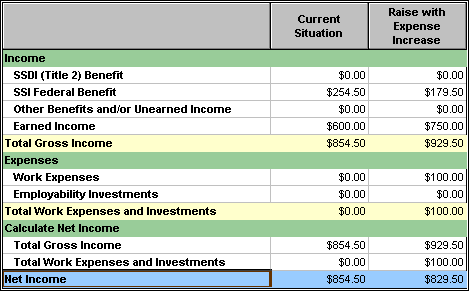
If your screen does not let you see the entire results, you have three options:
1. You can use the scroll bars to see the rest of the results.
2. You can set the View to maximize the Outputs.
3. You can "grab" the horizontal separator bar between the input and output areas on your screen with your mouse and stretch the output area to see more of it.
Your SSI cash benefit drops from $254.50 to $179.50. Since your earnings increase from $600 to $750, however, your Total Gross Income rises from $854.50 to $929.50.
Subtracting your work expenses of $100, though, causes your Net Income to decrease from your current $854.50 to $829.50.
![]() Switch to the Graph Results either by clicking on the "Graphs" tab located in the bottom-right of your results screen or by holding down the "Alt" key and typing "G". You now see:
Switch to the Graph Results either by clicking on the "Graphs" tab located in the bottom-right of your results screen or by holding down the "Alt" key and typing "G". You now see:

If you see a graph other than the one shown above (Income & Expenses) click the Income and Expenses button at the top left of the bottom (output) panel. When the Graphs tab has been selected, you can see the focus box around the selected graph option. From the keyboard, use your <Up arrow> and <Down arrow> keys to select other graph options.
For each of the two situations (your current situation and the first "What-If" situation) the graph has three bars. The bars on the left (blue) show that your Total Gross Income goes up. The middle bars (yellow) show that your expenses also go up. And the bars on the right (red) show that your Net Income goes down a little if you take the $150 raise and incur the $100 transportation expenses.
![]() Click on the Text Results tab located in the lower-left part of the Results screen. You now have two columns of Text Results. In the 2nd column you see three recommendations as you scroll down: (1) Try using a PASS; (2) PASS Possibilities; and (3) Try using an IRWE.
Click on the Text Results tab located in the lower-left part of the Results screen. You now have two columns of Text Results. In the 2nd column you see three recommendations as you scroll down: (1) Try using a PASS; (2) PASS Possibilities; and (3) Try using an IRWE.
The first recommendation, "Try using a PASS", suggests that you see what happens if you include your $100 of work expenses in a PASS. You don't understand how a PASS works, though, so you click on the "More Information" link below the recommendation, and the following screen pops up:
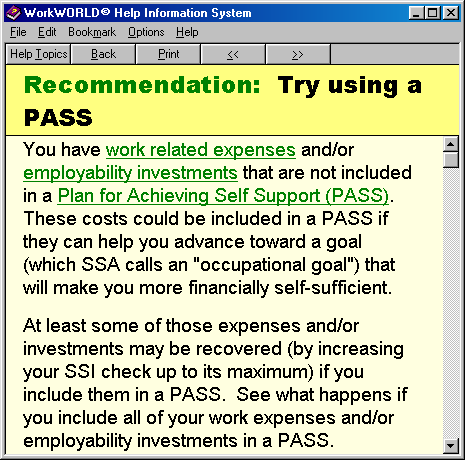
Since your goal is to get the raise, your PASS would end as soon as you got the raise and had the para-transit expenses. So you realize that a PASS is not an option for you.
You skip over the second Text Result Recommendation, since it also involves a PASS. The third Recommendation, "Try Using an IRWE", may be more relevant. It says:
"Try including all of your disability-related work expenses, $100.00, in an IRWE (if you can't include them in a PASS)."
You click on the "More Information" link below that recommendation and the following screen pops up:
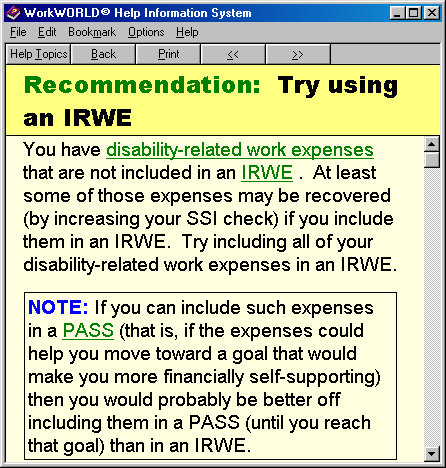
Although this explanation does not tell you very much more than the Text Result recommendation itself, it does allow you to go to explanations of terms such as "disability-related work expenses", "IRWE", and "PASS" by clicking on them.
Following the explanation portion of the Recommendation are directions for "What-If? Steps" that you should take if you want WorkWORLD to calculate the effects of including your disability-related work expenses in an IRWE. You will now follow these steps as part of the tutorial. Here they are:
1. ![]() Create a New Situation.
Create a New Situation.
2. Choose the column containing the recommendation (Raise with Expense Increase) as the column on which to base the new situation. When the "Choose Situation" window pops up, use the down-arrow key to highlight the correct situation, then press <Enter> to accept it. (The new column will contain the same answers as the chosen situation until you make changes.)
3. At the top of the new column, in the open question box, enter a situation name such as "Using IRWE", then press <Enter>.
4. Then scroll down to the question in the Work Incentive Information (SSI/DI) section, "IRWE-SSI: Are you claiming any of your disability-related work expenses as Impairment Related Work Expenses (IRWEs) in order to increase your SSI benefit amount?" Answer, "Yes".
5. Refer to "Text Results" for the amount you can include in the IRWE. WorkWORLD has already opened the question box and entered the amount ($100.00) by default. You accept it by hitting <Enter>, or by clicking on "Okay".
6. Notice that WorkWORLD now tells you that the Situation is complete.
Review the Numerical and Graph Results and compare them to the Results for the previous situation.
Here is what you see in the Numerical Results:

Including your disability-related work expenses in an IRWE caused your SSI Benefit to go from $179.50 to $229.50 per month and your Net Income to go from $829.50 to $879.50 per month.
And you see that compared to your current situation your Net Income goes from $854.50 to $879.50 if you accept the $150 raise and incur the $100 in para-transit expenses, as long as you include those expenses in an IRWE.
Going to the graphical results, you see:
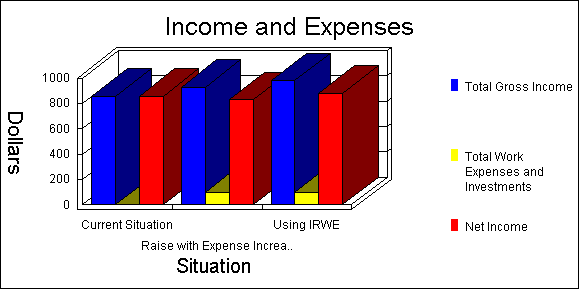
The left (blue) bars in the three situations show that your gross income goes up in the "Raise with Expense Increase" situation, and then goes up still further in the "Using IRWE" situation.
The middle (yellow) bars show that your work expenses also go up in the "Raise with Expense Increase" situation and stay the same in the "Using IRWE" situation.
The right (red) bars show that your net income goes down in the "Raise with Expense Increase" situation and then up, higher than in the current situation, in the "Using IRWE" situation.
If you want to look at a graphical breakdown of the income, you click on "Income Details" in the panel to the left of the Income and Expenses graph.
This graph appears:
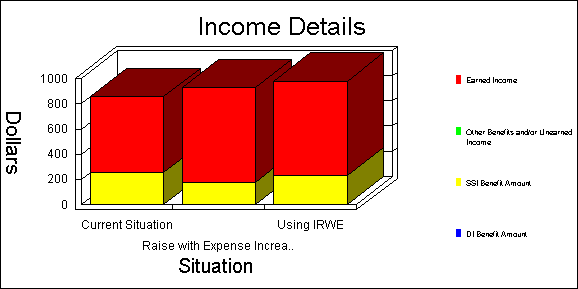
In this graph there is one stacked bar for each situation. The bottom (yellow) part of each bar is the SSI Benefit Amount. It goes down in the "Raise with Expense Increase" situation and then back up in the "Using IRWE" situation, almost as high as in the "Current Situation".
The upper (red) part of each bar is the earned income amount. It goes up in the "Raise with Expense Increase" situation and stays the same in the "Using IRWE" situation.
Now, to look at the expense details graphically, click on "Expense Details" in the panel to the left of the income graph. The following graph appears:

Like the "Income Details" graph, this graph has one stacked bar chart for each situation. Since there are no "Employability Investments" involved, however, you see just a single (blue) bar in the "Raise with Expense Increase" and "Using IRWE" situations showing the $100 of work expenses if you accept the raise.
![]() Finally, you go back to the Text Results by clicking on the "Text Results" tab in the lower left of the screen. You see that the PASS recommendation is still there, and it begins to intrigue you. It says:
Finally, you go back to the Text Results by clicking on the "Text Results" tab in the lower left of the screen. You see that the PASS recommendation is still there, and it begins to intrigue you. It says:
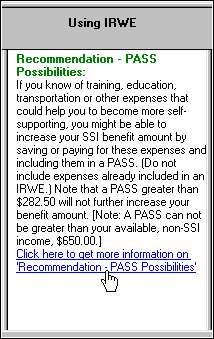
You click on the "More Information" link under this recommendation and the following screen pops up:
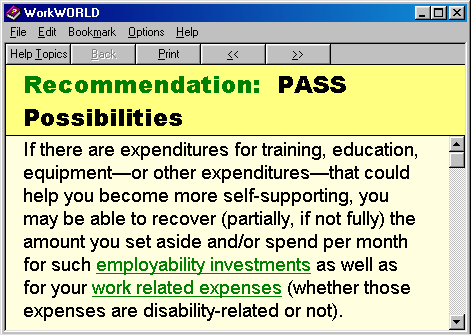
You could recover the amount you set aside by including that amount in a Plan for Achieving Self-Support) (PASS) and having your SSI check raised to its maximum amount.
You see that the amount you could include in a PASS (and raise your SSI to its maximum) once you have an IRWE, $282.50 in this recommendation, is less than the similar recommendation in the previous situation, "Raise with Expense Increase." In that situation the amount was $332.50.
You realize that you could get a really hefty raise (to $1,250 per month) if you were to become certified. Part of the certification requirements is on-the-job experience in the new job you have been offered. You investigate and find that it would cost you $1,800 in tuition, books, and transportation to take the 9-month course leading to certification. That would be $200 per month. Add the $100 per month of para-transit expenses for the raise you are considering, and that's $300 per month -- which is less than the $332.50 in the recommendation.
So you decide to let WorkWORLD calculate the results if you were to invest in your employability by taking the certification course and accepting the new job as a way to meet the experience requirements of certification. The "What-If?" Steps are:
1. ![]() Create a New Situation.
Create a New Situation.
2. Choose the situation containing the original recommendation ("Raise with Expense Increase") as the column on which to base the new situation. (The new column will contain the same answers as the chosen column until you make changes.)
3. At the top of the new column, enter a situation label such as "Using PASS" in the opened question box.
4. Then scroll down to the Employability Investment section. Answer "Yes" to the question, "Employability Investments: Are you spending or saving for any educational or training expenses, equipment purchases, or other expenses that should improve your future financial self-sufficiency? (Only the first line of the question will be visible until you click on the answer box.)
5. As soon as you enter a "Yes" answer you will be asked the amount of the employability investment. Enter the amount ($200.00, from discussion above) you would like to spend or save to become more self-supporting.
6. Refer to the "Text Results" recommendation in the situation you are basing this situation on (the second column, "Raise with Expense Increase") for the highest total amount of work expenses and employability investments ($332.50) that will result in a benefit increase in this situation.
NOTE: You may enter a higher amount if you that is what you want and are able to spend or save, but the extra amount will not be recovered through SSI. (The recommended amount raises your SSI check to the maximum for your situation.) If, however, you have other benefits such as housing subsidies or food stamps, then including the full amount may cause those benefits to be higher. Check with the applicable agencies.
7. As soon as you accept the amount, the situation will be complete. However, you want to see the results of using a PASS. In the Plan for Achieving Self-Support section, you click on the answer box for the question, "PASS reducing Countable Income: Are you claiming any of your employability investments and work expenses under a Plan for Achieving Self Support (PASS)?" Answer "Yes".
8. You will then be asked, "How much of these employability investments and work expenses per month are you claiming under a PASS?" Normally, you would accept the amount that is already in the box unless you have a reason to enter a lessor amount. The amount already entered will be the sum of the work expenses ($100) and employability investments ($200) you entered above. You click Okay to accept the $300 amount.
The situation is complete. Review the results and compare them to the previous results (without the employability investments and PASS).
![]() Click on the Numerical Results tab and you will see:
Click on the Numerical Results tab and you will see:
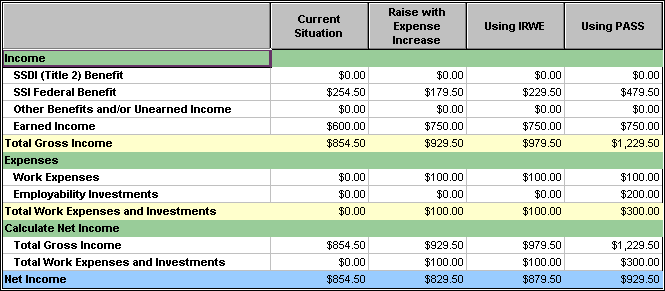
Your SSI benefit rises from $229.50 to $479.50, your gross income rises from $979.50 to $1,229.50, and your Net Income goes from $879.50 to $929.50. In addition, you are able to invest $200 a month in your employability.
![]() Switch to the graphical results by clicking on the "Graphs" tab, and you see:
Switch to the graphical results by clicking on the "Graphs" tab, and you see:
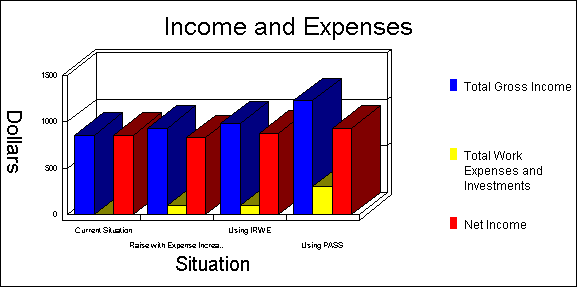
The left (blue) bars show the rise in gross income; the middle (yellow) bars show the addition of employability investments; and the right (red) bars show the increase in net income.
Finally, you want to see how you will be doing if you carry out the plans you've been using WorkWORLD to help construct. So you:
1. ![]() Create a new situation. Pick "Using IRWE" as the column to be copied to the new situation since you expect to still have the transit expenses and will want to use an IRWE to be reimbursed for part of those expenses.
Create a new situation. Pick "Using IRWE" as the column to be copied to the new situation since you expect to still have the transit expenses and will want to use an IRWE to be reimbursed for part of those expenses.
2. In the opened situation label answer box enter, "$1250 with no PASS".
3. Then scroll down to the question, "How much do you RECEIVE monthly from wages, salary or self-employment?" and enter 1250.
The situation is complete, and you can analyze the results.
The numerical results are:
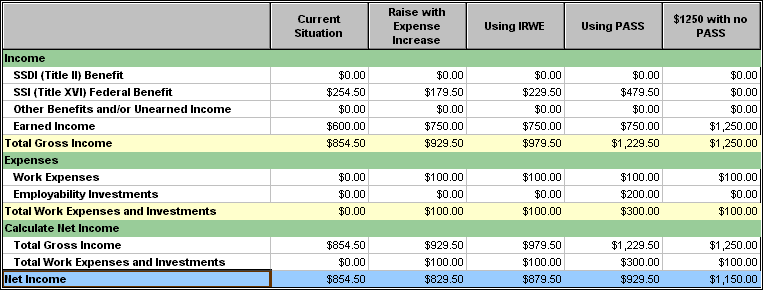
The numerical results show that even though your SSI benefit goes to zero, your net income rises from $929.50 to $1,150.00.
The text results reveal one of the best reasons for using Decision Support Software like WorkWORLD. One of the text results is an Alert about losing Medicaid coverage:
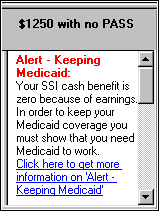
It warns you that by losing eligibility for SSI by significantly increasing your monthly income, you lose your automatic Medicaid eligibility. Clicking the More Information link pops up a help screen that provides information about the 1619(b) program (and a link directly to the detailed 1619(b) help topic), designed to help people who need it keep their Medicaid coverage while improving their employment outcome. This alerts you to the fact that you must plan for this eventuality while you plan this course of employment.
The last text result is a recommendation about PASS possibilities. You are still technically getting SSI, even though the benefit amount is zero. It is possible in such a situation to start getting cash benefits by using a PASS, if you have a new occupational goal.
And finally, the graphical results are:
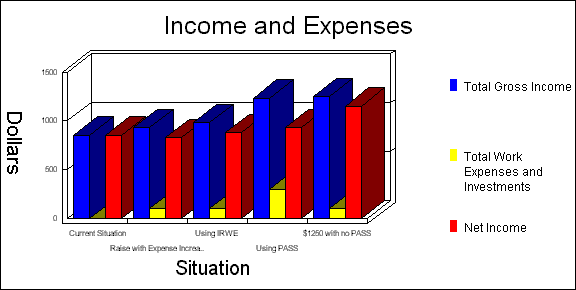
You want to be able to refer to what you entered and the results at a later time, so you decide to save this data to avoid entering it again.
From the Main Menu bar, you click "File", then "Save As…". This brings up the "Save As" dialog box, and you enter "Tutorial Example 1" (or any other name you wish) for the File Name:
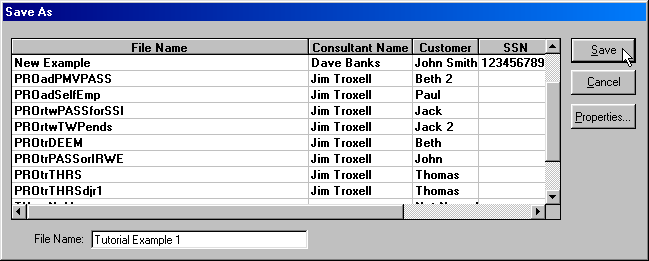
Then you click on the "Properties…" button in order to enter your name and Social Security number, and the name of any consultant who may have helped you in a small pop-up window:
NOTE: You do not have to enter any of this information if you do not want to make the file identifiable for security reasons:
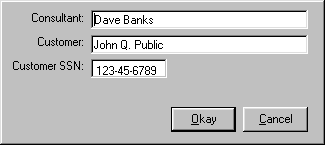
Click the "Okay" button to accept the properties information you entered. The properties window goes away.
Finally, you click the "Save" button and WorkWORLD displays the file name and customer name on the status bar at the bottom of the screen, and the file is saved on your computer.
You may open this file at any time in the future, and WorkWORLD will use all the data you entered today to display results then.
As well as explaining the operation of some of the features of WorkWORLD, this tutorial shows how you can use WorkWORLD as a decision support tool. The five situations explored are summarized below.
In this example, you are a recipient of Supplemental Security Income (SSI) working part time, earning $600 per month. Your part time earnings plus SSI give you a net monthly income of $854.50. You have been offered a substantial pay increase to take on new duties. Unfortunately, you will have work expenses due to the new duties and to your disability.
You use WorkWORLD to see if it makes financial sense for you to take the offer. Although your gross earned income would increase by 25%, your SSI benefit would be reduced. You would also have to pay for new work expenses. These factors combined yield a net income that is slightly less than your current situation, an outcome you might not expect from such a large pay increase.
Based on a recommendation from WorkWORLD, you explore the possibility of using one of the work incentives available to SSI recipients, Impairment Related Work Expenses (IRWE) in conjunction with the new job offer. This allows you, in this situation, to recover half of the amount you spend to pay for the expenses in the form of increased SSI benefits. Your SSI benefit amount is slightly less than your current situation, but your total net income, even after the work expenses, is slightly greater than your current situation.
Following another WorkWORLD recommendation, you test the consequences of using a different type of work incentive, a Plan for Achieving Self-Support (PASS). You think that, perhaps, you can use the new job offer in conjunction with additional training to become certified, which would allow you take a new position with a really hefty pay increase. Your work expenses could be included in the PASS along with the cost of the training while you work in the new job to get the experience required for certification.
Even though you spend $300 a month for work expense and investments, the PASS causes your SSI benefit to increase over your current situation and you are getting the pay raise. Your net income during the period of the PASS is greater than your current situation.
You want to make sure that, if you follow the plan you worked out using the PASS, you will be better off once you reach your occupational goal and the PASS ends. Your ongoing work expenses at that time would go into an IRWE.
You discover that your SSI cash benefit would be reduced to zero due to your much higher income. But in your new higher paying position, you have a net monthly income that is almost $300 more than your current situation. WorkWORLD alerted you about continued Medicaid coverage.
Instead of working part time and being dependent on SSI benefits, you now have a well thought-out plan to become self-supporting in a much better job at a much higher pay rate.
Click this link to return to the start of tutorial instructions.
WorkWORLD™ Help/Information System
Topic Title: Tutorial Example 1
Topic URL: https://help.workworldapp.com/wwwebhelp/tutorial_example.htm
Bookmark: To bookmark page, first follow Topic URL link above. Then use (CTRL-D).
Print: Print this topic page.
NOTE: Table of Contents, Index, and Search facilities within the WorkWORLD Help/Information System, if not visible, are available by clicking the blue "Show Navigation" link at the extreme top left of this page. See Using the Help/Information System On The Web for additional information about this and other features of the system.
| Translate this page in a new window by selecting a language below. Machine translation services are offered as a convenience, and should only be used to obtain the "gist" or general meaning of the page content. No endorsement of this commercial service is intended or implied. | |||||||
Spanish | French | German | Italian | Portuguese | Norwegian | Dutch | |
![]() Share/Save: Click the button or link at left to select your favorite bookmark service and add this page.
Share/Save: Click the button or link at left to select your favorite bookmark service and add this page.
This is one topic from the thousands available in the WorkWORLD™ software Help/Information System.
Complete information about the software is available at: http://www.WorkWORLD.org
See How to Get WorkWORLD page at: http://www.WorkWORLD.org/howtogetWW.html
NOTE: Sponsored links and commercial advertisements help make the WorkWORLD™ website possible by partially defraying its operating and maintenance expenses. No endorsement of these or any related commercial products or services is intended or implied by the Employment Support Institute or any of its partners. ESI and its partners take no responsibility for, and exercise no control over, any of these advertisements or their views or contents, and do not vouch for the accuracy of the information contained in them. Readers are cautioned to verify all information obtained from these advertisements prior to taking any actions based upon them. The installed WorkWORLD software does not contain advertisements of any kind.
Copyright © 1996, 1997, 1998, 1999, 2000, 2001, 2002, 2003, 2004, 2005, 2006, 2007, 2008, 2009, 2010, 2011, 2012, Virginia Commonwealth University. All rights reserved.
Page Last Updated: 02/01/2012 06:00:00